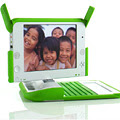
I haven't been blogging regularly and it's true that it's just not the same to be in Washington, D.C. with nothing exciting to write about.
It is my duty to report on a new gadget though. I am not really a gadget-kind of person but this time, this is something I can wholeheartedly support. But only because I thought of it three years ago!
It is my duty to report on a new gadget though. I am not really a gadget-kind of person but this time, this is something I can wholeheartedly support. But only because I thought of it three years ago!
The $100 computer!
Can socially responsible design change the world? Fuseproject's product design of the new One Laptop Per Child (OLPC) XO computer can. Honored by "Popular Science" magazine's "Best of What's New" Grand Award, the XO computer marries fuseproject's high-concept design with cutting-edge technological solutions for a very low price.
The goal of the project is both simple and worthy: to give every child a laptop computer, especially in developing countries, where the machines will be sold in bulk for about $130 each. The revolutionary child-size laptop was created by the nonprofit OLPC, which was formed at Massachusetts Institute of Technology by Nicholas Negroponte. It brings learning, information and communication to children where education is needed most: in developing countries.
The result is a cheap and energy efficient computer. The machine's reduction in energy use by 90 percent is ideal for a device that could be charged by hand cranked power in rural villages. The OLPC is designed as a compact, durable and expressive product. Every design aspect of the machine serves a dual purpose to achieve a sense of economy and efficiency. When closed, the entire unit is sealed, protecting it from dust and dirt.
It's not the price tag I like, or the fact that "every child" will have one (that's laughable). But I think the following features are essential for business workers in the developing world:
-a computer that uses a different source of energy than electricity;
-a computer that's durable and can bear the wear and tear of humidity, dirt, and dryness;
-a computer that has very basic functions (word, excel, and picture loading capacities).
Voila! There's no need for super technically sophisticated machine. Rather, the machine has to be adapted to the particularities of developing country settings.